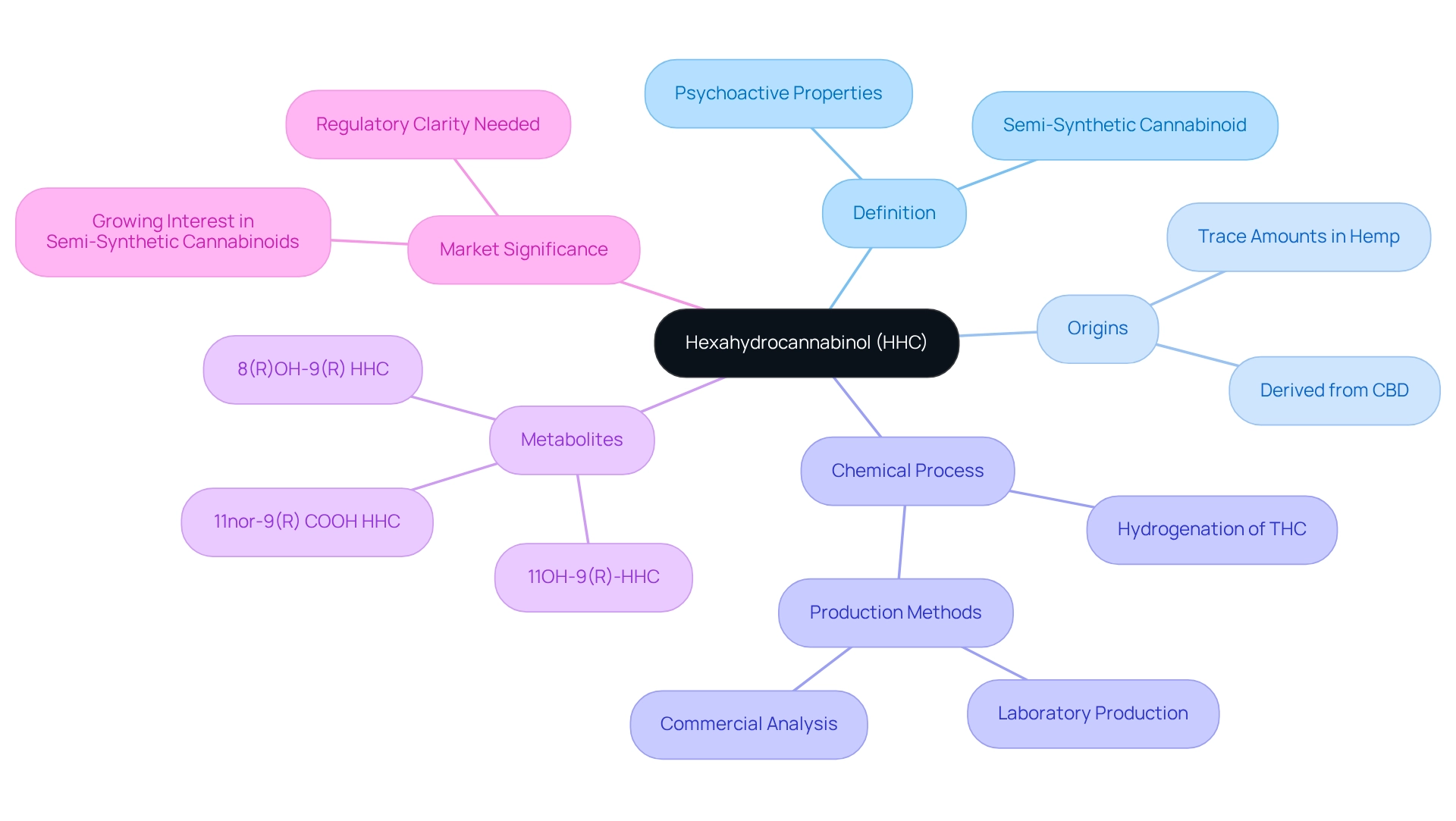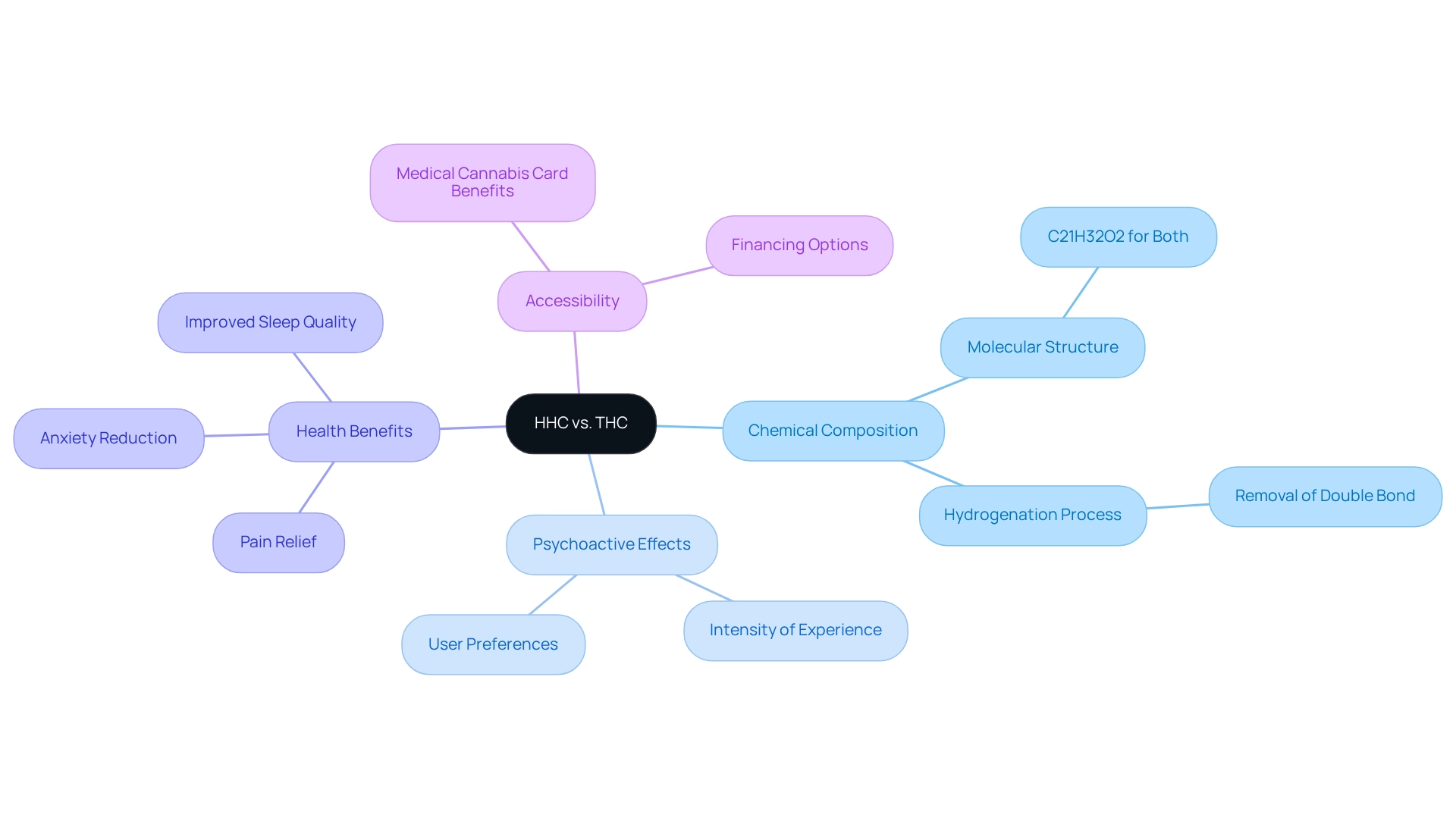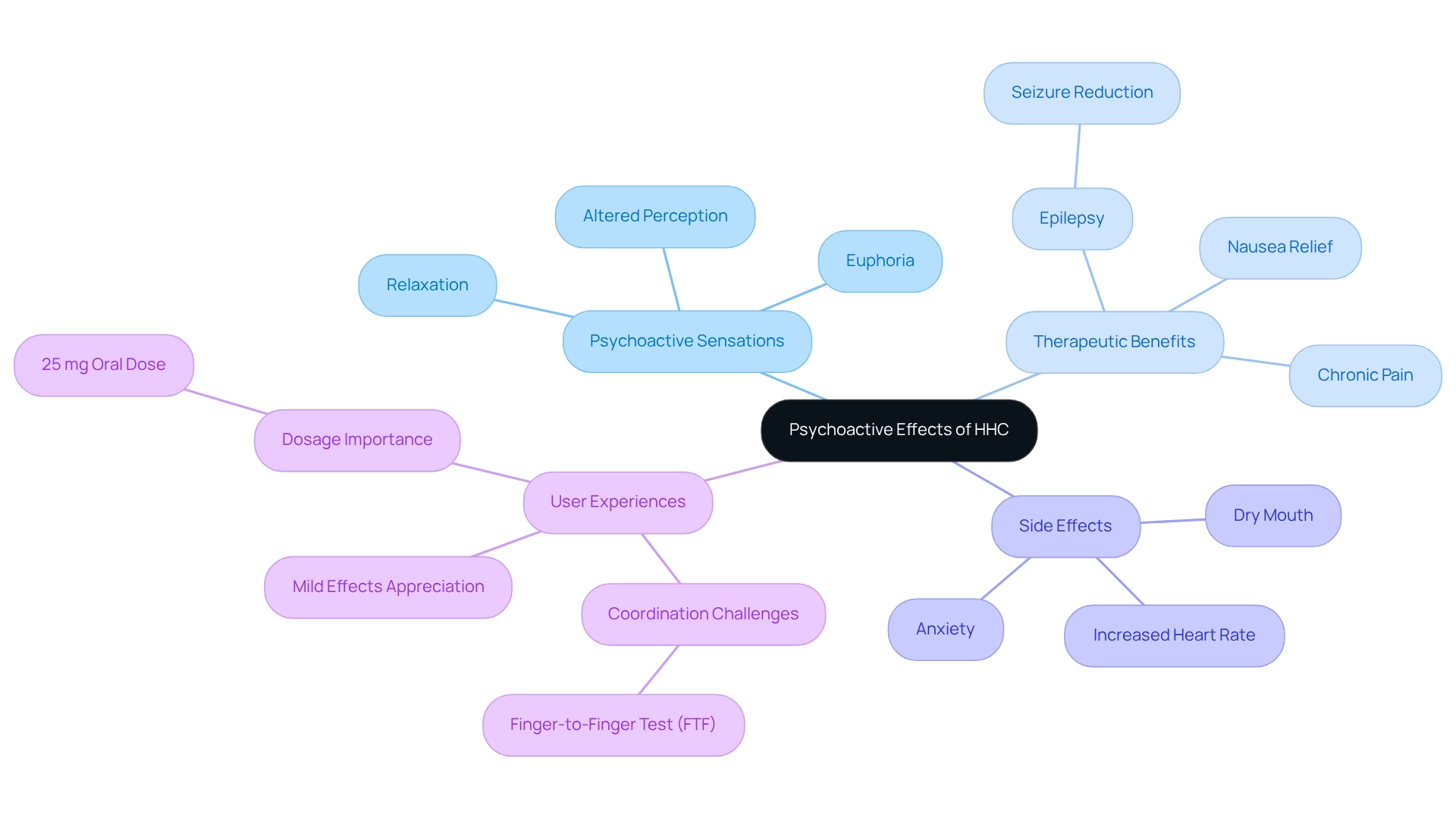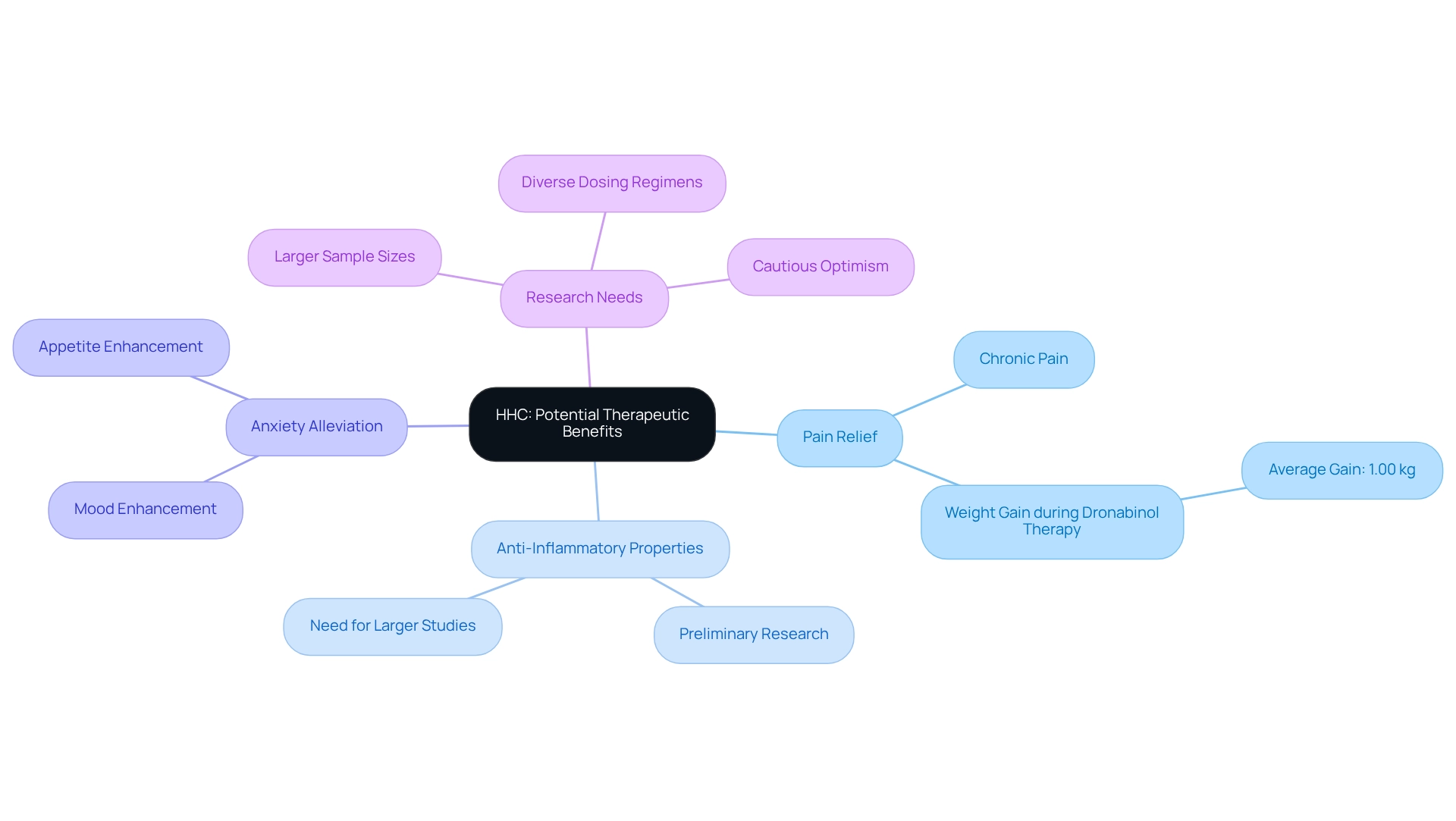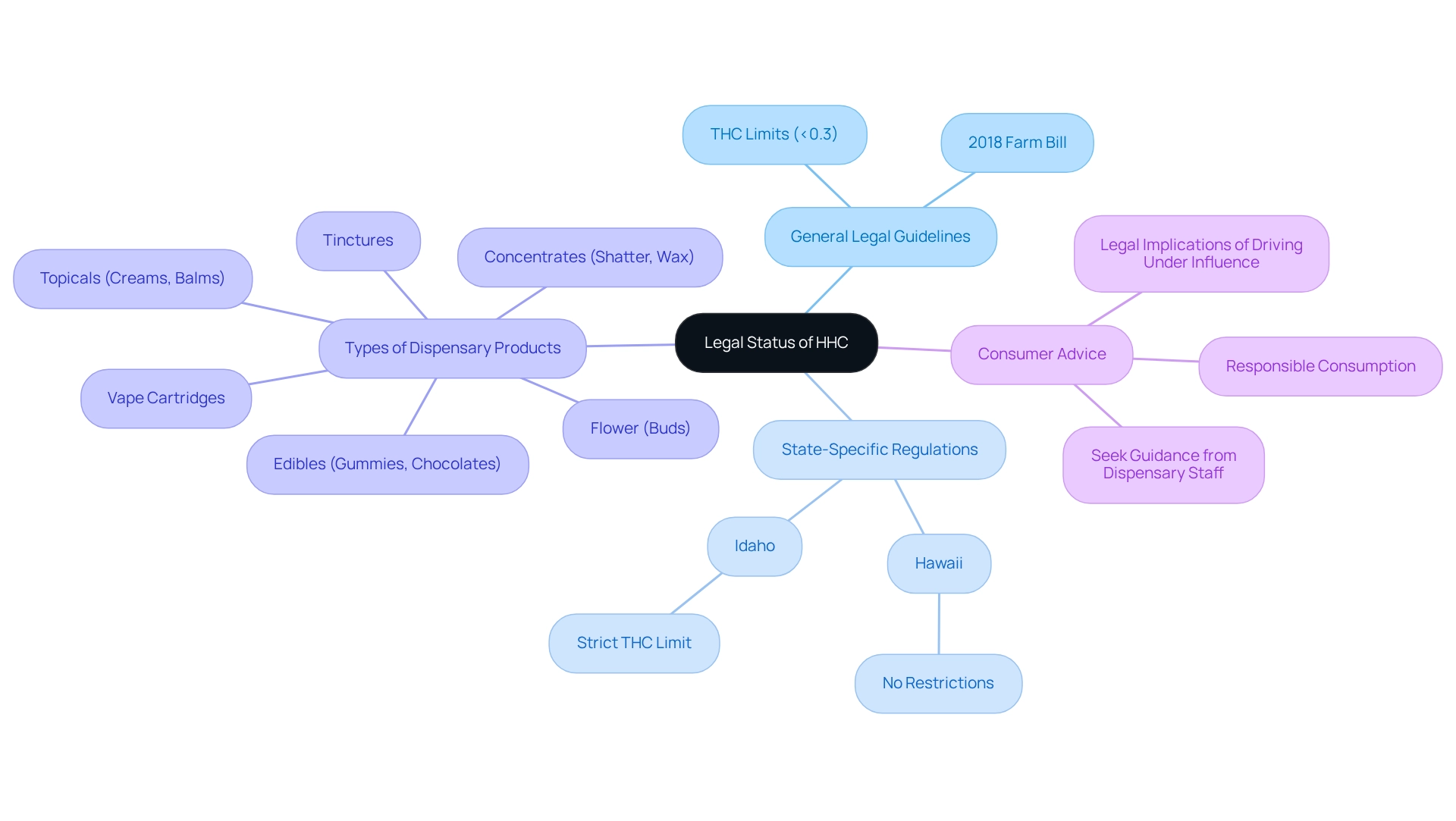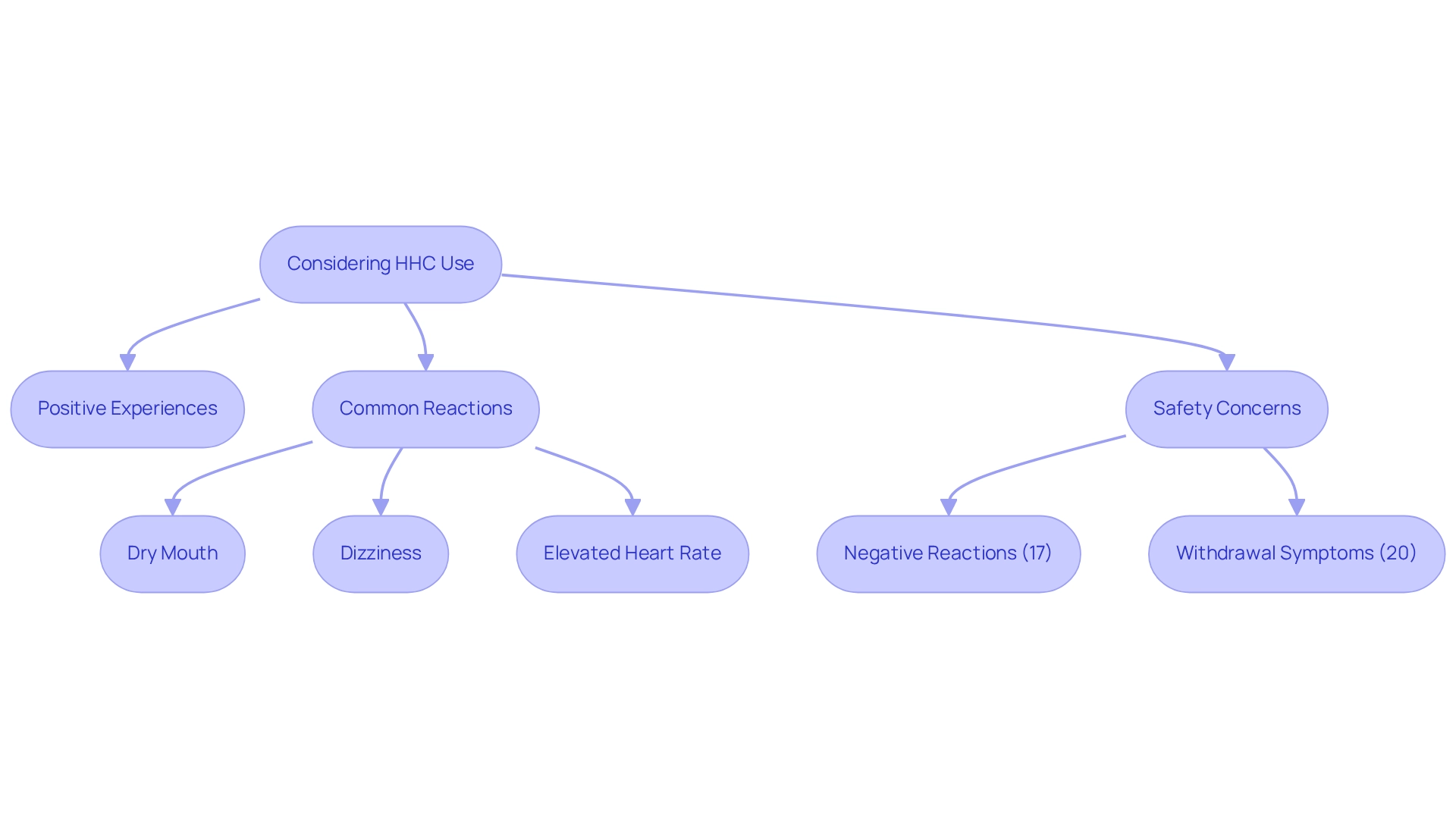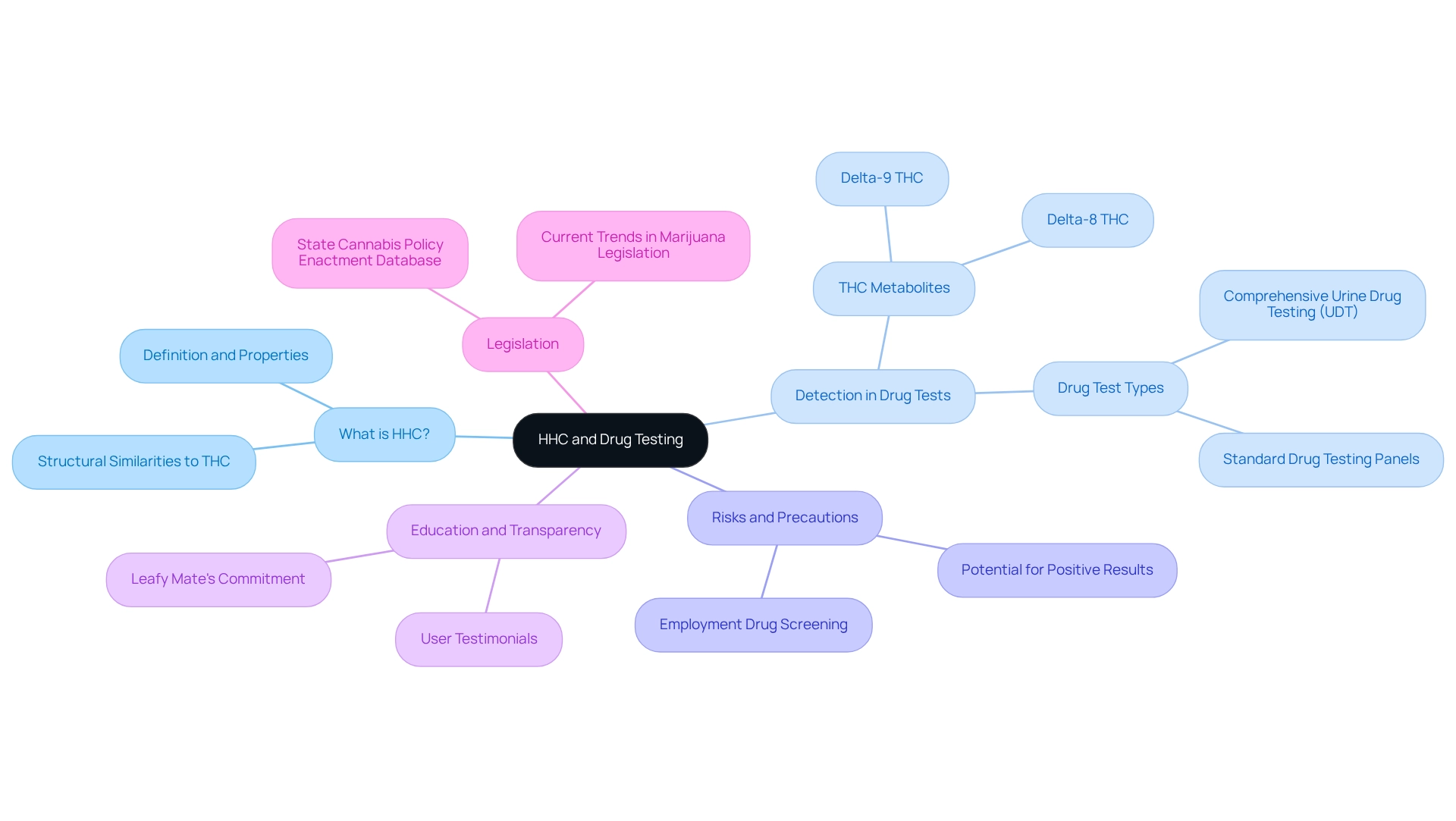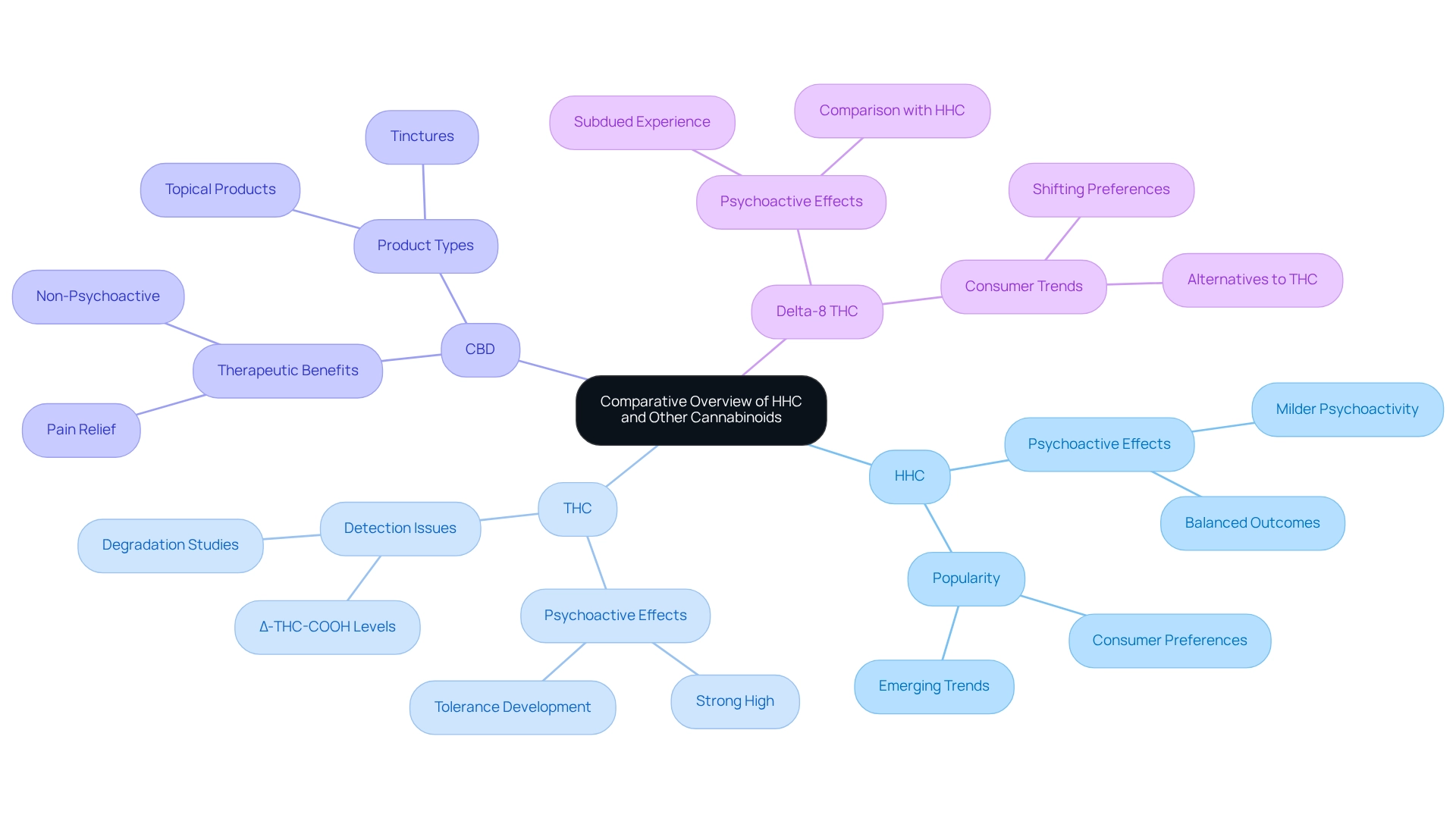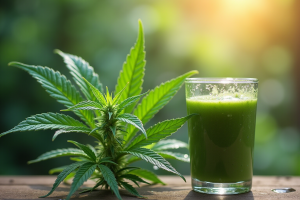Overview
Hexahydrocannabinol (HHC) is a semi-synthetic cannabinoid that emerges from the hydrogenation of tetrahydrocannabinol (THC). While it shares structural similarities with THC, many find its psychoactive effects to be milder. Understanding HHC is essential, as it plays a growing role in the cannabis market.
In this article, we explore HHC’s origins, production methods, and chemical properties. We also delve into its potential therapeutic benefits, which may resonate with those seeking alternative treatments. As we navigate this evolving landscape, it’s crucial to grasp HHC’s effects and legal status, empowering you to make informed choices.
Have you wondered about the implications of these developments for your health and well-being? By staying informed, we can better understand how HHC might fit into our lives. Together, let’s explore this fascinating cannabinoid and its significance in the cannabis community.
Introduction
In the rapidly evolving world of cannabinoids, hexahydrocannabinol (HHC) is capturing our attention with its unique properties and potential benefits. Have you ever wondered how a cannabinoid can offer a milder psychoactive experience while still providing therapeutic advantages? Derived from the hydrogenation of tetrahydrocannabinol (THC), HHC does just that, making it an intriguing option for both consumers and industry professionals.
As we seek to understand this semi-synthetic cannabinoid together, it’s important to explore the complexities surrounding its production, effects, legal status, and safety. This article invites you to delve into the origins of HHC, its chemical composition, and its psychoactive effects. Ongoing research continues to highlight its therapeutic potential, further emphasizing the need for informed decision-making.
With the cannabis landscape continually shifting, grasping the nuances of HHC is essential. Together, let’s embark on this journey of discovery, ensuring that we are well-informed in both medical and recreational contexts. Your understanding matters, and we are here to support you every step of the way.
Understanding Hexahydrocannabinol (HHC): Definition and Origins
What is HHC? Hexahydrocannabinol (HHC) is a semi-synthetic cannabinoid that comes from the hydrogenation of tetrahydrocannabinol (THC). This innovative process was pioneered by chemist Roger Adams in the 1940s. By adding hydrogen to THC, Adams changed its chemical structure, leading to the creation of HHC. Many believe HHC has psychoactive properties similar to THC, though it can have different effects and stability. While HHC does occur naturally in hemp plants, it is typically present only in trace amounts, making extraction impractical.
Understanding what HHC is, is important because it is mainly produced in laboratories. This production method allows for greater availability and examination of its characteristics. Recent research has shed light on HHC and its growing significance in the hemp market, especially as interest in semi-synthetic cannabinoids continues to expand. For example, a commercial analysis of HHC in various cannabis products found that the R epimer of HHC consistently appears in higher concentrations than its S counterpart.
This finding highlights the importance of understanding what HHC is, particularly regarding its synthesis and regulation. Given that HHC is derived from CBD with Δ-THC as an intermediate, it’s crucial to stay informed. The metabolites of HHC, such as 8(R)OH-9(R) HHC and 11OH-9(R)-HHC, have been detected in blood, with 11 nor-9(R) COOH HHC being the most prevalent metabolite across various time points. This underscores the need for ongoing research and monitoring of HHC and related substances, especially in the context of the evolving European drug market. As the landscape of cannabinoids continues to change, understanding what HHC is, along with its origins and synthesis, will be essential for both consumers and industry experts alike.
Additionally, the time for assessing catalepsy in the bar test was observed to be up to 5 minutes, providing valuable context regarding the impacts of HHC. Gaoni et al. suggested that the isomer labeled as Via, which exhibited a proton signal at C10 (C3 in the old numbering system) appearing ‘as a broad doublet centered at 2.85 ppm’, corresponds to the isomer with the methyl group at C9 (C1 in the old numbering system) in the axial position (( )-HHC).
This scientific insight further emphasizes the complexity of HHC. It highlights the importance of understanding what HHC is and the necessity for close monitoring and research on HHC and related substances in the European drug market. Together, we can navigate this evolving landscape with awareness and informed choices.
Chemical Composition: How HHC Differs from THC
HHC and THC share a striking resemblance in their molecular structures, yet a crucial distinction arises from the hydrogenation process that HHC undergoes. This process effectively removes the double bond found in THC, resulting in enhanced stability for HHC, making it less prone to degradation over time. The molecular formula for HHC is C21H32O2, mirroring that of THC.
However, the absence of the double bond at the ninth carbon atom changes how HHC interacts with cannabinoid receptors in the body. This modification may lead to less intense psychoactive experiences compared to THC. Many individuals are curious about what HHC is, considering it an appealing option for those seeking similar advantages without the strength associated with THC. Recent studies suggest that HHC’s stability is a key factor in its growing popularity, especially among users looking for milder sensations while still benefiting from the therapeutic properties of cannabinoids.
As an alternative to THC, HHC is attracting interest, particularly among those wondering what HHC is for softer experiences. Borja Iribarne, CEO and founder of ProfesorCBD, shares, “HHC offers a unique profile that can benefit users looking for a less intense experience while still enjoying the therapeutic properties of cannabinoids.” A case study titled “Health Benefits of HHC and THC” highlights that both cannabinoids have potential health benefits, including pain relief, anxiety reduction, and improved sleep quality.
Furthermore, obtaining a Medical Cannabis Card through Leafy Mate can enhance access to these products. This card allows for larger purchase limits, exclusive patient-only sales, and a wider selection of medical-only dispensaries. It also provides increased protections for patients, ensuring a supportive experience. With 24/7/365 support, Leafy Mate is always available to assist new marijuana users.
Additionally, financing options are available to help save hundreds of dollars annually. In saliva, only (9)-HHC was detectable immediately after consumption, with concentrations decreasing rapidly. Maximum detection times were 8 hours after oral and 5 hours after inhalative consumption. This information underscores the importance of understanding what HHC is, along with its effects and stability for new marijuana users.
The Production of HHC: Hydrogenation Explained
What is HHC? It’s a question that many may have as they explore the world of cannabinoids. HHC is primarily produced through the hydrogenation of THC or CBD, a process that involves adding hydrogen atoms to the cannabinoid structure. This is typically achieved using a catalyst under controlled conditions, enhancing the stability of the compound and facilitating the conversion of legal hemp-derived CBD into HHC. This adherence to regulations in various areas makes HHC an attractive choice for consumers.
However, as we delve into what HHC is, it’s essential for new marijuana consumers to familiarize themselves with local laws and regulations concerning marijuana use and possession. Understanding legal purchase limits, consumption locations, and age requirements is crucial for responsible use. For instance, many regions set age limits, often requiring buyers to be at least 21 years old, and may restrict the quantity of marijuana that can be purchased at one time.
In understanding what HHC is, we recognize that the current landscape of HHC production is marked by a lack of standardization, raising significant concerns regarding the purity and safety of HHC products available in the market. Research shows that improper hydrogenation methods can lead to undesirable byproducts, potentially compromising product quality. For example, long-term storage of CBD products must be monitored to prevent the accumulation of cannabinol (CBN), which may exhibit psychotropic effects.
Crippa et al. discovered that 300 mg of orally administered CBD did not convert to Δ-THC in 120 healthy human subjects. This emphasizes the importance of understanding the safety and effectiveness of CBD and its derivatives.
A notable case study on the hydrogenation of hemp oil illustrates what HHC is and its potential therapeutic applications. This process allows for the conversion of cannabinoids and other compounds in cannabis oil into hydrogenated derivatives, showing promising benefits in treating conditions such as cancer. The outcomes of this case study highlight the need for ongoing research into the structure-activity relationship (SAR) of cannabinoid derivatives, as recent findings underscore the importance of further studies on machaeriol and machaeridiol derivatives to improve receptor selectivity and ensure product safety.
In light of these developments, expert opinions, including insights from G.G., emphasize the necessity for rigorous safety assessments and standardized production methods to mitigate risks associated with HHC consumption.
As we navigate the complexities of HHC products together, understanding what HHC is—along with the production methods and the legal landscape—will be essential for making informed choices.
Psychoactive Effects: What to Expect from HHC
Many users of HHC share that they experience mild psychoactive sensations, often characterized by a gentle euphoria and relaxation. While HHC is generally seen as less potent than THC, it can still elicit significant responses, such as altered perception, mood enhancement, and a sense of calm. It’s important to note that these effects can begin within 30 minutes to 2 hours after ingestion, lasting several hours depending on the method of intake and individual tolerance levels.
Beyond its psychoactive effects, HHC may offer therapeutic benefits similar to those of medical marijuana, particularly for conditions like epilepsy, chronic pain, multiple sclerosis, and chemotherapy-related nausea. For instance, medical marijuana has been shown to reduce seizures in children with severe epilepsy by up to 50%. This finding brings hope to families seeking effective treatment options.
As a derivative of hemp, HHC may serve as a comforting alternative for individuals looking for relief without the adverse side effects often associated with traditional treatments.
User experiences indicate that while many appreciate the milder effects of HHC, some may encounter side effects akin to those of THC, such as dry mouth, increased heart rate, and anxiety, especially when consuming larger amounts. A recent study found that an oral dose of 25 mg of HHC effectively produced these psychoactive effects, underscoring the importance of dosage in shaping the overall experience. Additionally, the Immunalysis ELISA for serum was positive for at least 24 hours after consumption, confirming its effectiveness in detecting HHC use.
Moreover, this study received approval from the ethics committee of the medical faculty at the University of Leipzig and was conducted in line with the Declaration of Helsinki. Informed consent was obtained from all participants, ensuring that ethical standards were maintained throughout the research.
Case studies, including the Finger-to-Finger Test (FTF), have shown that HHC can affect coordination, with participants exhibiting varying degrees of fine motor skill challenges. This emphasizes the importance of understanding how HHC impacts motor functions, particularly for those engaged in tasks requiring precision.
In conclusion, while HHC offers a unique alternative to THC, it’s essential for users to consider what HHC is and its potential effects and side effects. This awareness promotes informed choices in their journey with cannabis. By exploring the medical benefits of cannabis, individuals can discover what HHC is and how it can empower them to take charge of their health and explore alternative treatment options that may enhance their well-being. Together, we at Leafy Mate are dedicated to providing the information and resources needed to support this journey.
Potential Benefits of HHC: Therapeutic Uses and Effects
Currently, researchers are exploring what HHC is for its promising therapeutic advantages, particularly in pain relief, anti-inflammatory properties, and anxiety alleviation. Preliminary studies suggest that HHC may interact with cannabinoid receptors in a way that could effectively alleviate chronic pain and inflammation. This positions HHC as a viable candidate for future research in pain management therapies. It’s noteworthy that individuals in cannabinoid studies have reported significant advancements, with certain research revealing an average weight increase of 1.00 kg during dronabinol treatment. This emphasizes the promise of cannabinoids in medical settings and hints at a possible connection to appetite enhancement.
Furthermore, anecdotal reports suggest that HHC may boost mood and encourage relaxation, much like THC’s impact but possibly with a lower chance of anxiety or paranoia. This aspect is particularly appealing for those seeking relief without the common side effects associated with traditional THC consumption. In conjunction with HHC, topical CBD products from Leafy Mate provide remarkable relief and calming benefits. This makes them a superb option for those investigating marijuana for pain alleviation and improved wellness.
Research into HHC’s anti-inflammatory properties is gaining traction, with experts advocating for more extensive studies to validate these preliminary findings. For instance, a recent study acknowledged the limitations of existing research, emphasizing the need for larger sample sizes and diverse dosing regimens to fully understand HHC’s impact on pain relief and its safety profile. Additionally, it is important to recognize that there is currently insufficient evidence to support the effectiveness of cannabinoids for treating motor symptoms of Parkinson’s disease or levodopa-induced dyskinesia. This underscores the need for cautious optimism in cannabinoid research. As the landscape of cannabinoid research evolves, understanding what HHC is becomes crucial, as it stands out as a compound worthy of attention, particularly for its potential applications in pain management and its therapeutic benefits.
The ongoing exploration of HHC could pave the way for innovative treatments that harness its unique properties, ultimately contributing to a more nuanced understanding of cannabinoids in medical use. Moreover, utilizing DrugWipe 5 S tests for saliva detection and SureStep™ Multi-Drug Urine tests for urine samples, the safety and regulatory aspects of HHC are becoming clearer, which is essential for new users of marijuana. By combining the benefits of HHC with Leafy Mate’s topical CBD products and tinctures, consumers can unlock a world of transformative power and ultimate relaxation.
Click now to indulge in the ultimate relaxation and experience the incredible relief that Leafy Mate offers!
Legal Status of HHC: What You Need to Know
For new users, understanding what HHC is and navigating its legal status can feel overwhelming, especially given the inconsistent regulations across various regions in the United States. Generally, HHC is considered legal when derived from hemp and containing less than 0.3% delta-9 THC, in accordance with the 2018 Farm Bill. However, the landscape is complicated by state-specific regulations and potential bans, resulting in a fragmented legal framework.
While there are no specific laws restricting HHC in any state, it’s crucial to note that states with delta-8 restrictions may also consider HHC illegal. For instance, HHC remains unrestricted in states like Hawaii, which has no restrictions, while Idaho imposes a strict limit on THC content, reflecting a cautious regulatory approach. As you explore HHC products, it’s essential to familiarize yourself with local marijuana laws and regulations regarding its use and possession.
This includes understanding legal purchase limits, consumption locations, and age requirements. Dispensaries, whether medical or recreational, can provide valuable guidance on these matters. Medical dispensaries cater to patients with valid medical marijuana cards, offering products tailored for specific conditions, while recreational dispensaries serve adults aged 21 and over without the need for a medical card.
Dispensaries offer a variety of marijuana products, including:
- Flower (buds)
- Edibles (e.g., gummies, chocolates)
- Concentrates (e.g., shatter, wax)
- Vape cartridges
- Topicals (e.g., creams, balms)
- Tinctures
As of 2025, it is anticipated that upcoming marijuana legislation may confirm HHC’s legality nationwide within the next 24 months, although the current legal status remains subject to change. Additionally, driving while under the influence of HHC is illegal, even if it’s legal where you live, highlighting the need for consumers to be aware of local laws. Always consume cannabis products responsibly and avoid driving or operating heavy machinery while under the influence.
Remember, the staff at marijuana dispensaries are here to help you make informed decisions and ensure a positive experience. Don’t hesitate to ask questions and seek guidance based on your preferences and needs.
Safety and Side Effects: Is HHC Safe to Use?
Many users share positive experiences with Hexahydrocannabinol (HHC), yet the question of what HHC is and its safety profile remains inadequately explored due to limited research. Typical reactions associated with HHC usage may include dry mouth, dizziness, and an elevated heart rate, particularly at higher doses. A recent study, ‘HHC Use Patterns and Perceived Effects Study,’ published in the October 2024 edition of Cannabis and Cannabinoid Research, involved 109 participants. It revealed that while many sought HHC for anxiety and pain relief, approximately 17% experienced negative reactions, such as anxiety or paranoia, similar to those associated with THC. This finding prompts us to reflect on what HHC truly entails.
Moreover, around 20% of individuals who stopped using HHC reported withdrawal symptoms, highlighting the urgent need for more comprehensive research on both HHC and its therapeutic and adverse effects. As Morgan L. Ferretti, MA, from the Department of Psychological Sciences, remarked regarding the study’s supervision, these findings underscore the importance of informed decision-making within the context of marijuana use. Given these insights, we encourage new users to begin their journey with a low dose and attentively monitor their reactions to better understand what HHC is.
Additionally, the current lack of regulation in HHC production raises significant concerns about its quality and purity. This situation emphasizes the importance of seeking regulated and lab-tested marijuana products, which can enhance patient safety and ensure a positive experience. New marijuana consumers should take the time to familiarize themselves with local regulations and the types of products available at dispensaries, including the distinctions between medical and recreational options. Making informed choices that align with your needs is crucial.
Medical dispensaries cater to patients with valid medical marijuana cards, while recreational dispensaries serve adults aged 21 and over. Budtenders at these dispensaries can offer valuable guidance on product categories, including Indica, Sativa, and Hybrid strains, helping consumers navigate their options effectively. Together, let’s make informed choices that prioritize our well-being.
HHC and Drug Testing: What You Should Know
What is HHC, or hexahydrocannabinol? It’s important to know that it may indeed show up on drug tests, particularly those designed to detect THC metabolites. While standard drug testing panels do not specifically include HHC, its structural similarities to THC raise the possibility of a positive result. This is especially relevant since comprehensive urine drug testing (UDT) can identify metabolites of both delta-9 THC and delta-8 THC, which are closely related to HHC.
At Leafy Mate, we truly prioritize establishing trust in the industry through transparency and education. We encourage users to exercise caution, especially if they are subject to drug testing for employment or legal reasons. To mitigate the risk of unexpected complications, it’s advisable to abstain from using HHC prior to any drug screening.
Recent data indicates that while reported drug use among adolescents remained below pre-pandemic levels in 2023, the increasing rates of overdose deaths among teens, as reported on December 13, 2023, highlight the significance of understanding the implications of marijuana use, including HHC. Have you considered how these trends might affect your choices?
Moreover, the implications of HHC use extend to employment drug screenings, where the detection of THC metabolites can lead to adverse outcomes. A case study titled “Comprehensive Urine Drug Testing for Marijuana Use” emphasizes the importance of monitoring marijuana use, particularly in addiction recovery contexts. This approach aligns with national recommendations and enhances healthcare providers’ ability to tailor treatment plans effectively.
In summary, while HHC offers potential benefits, it’s crucial for users to be well-informed about its detection in drug tests and the associated risks. Understanding what HHC is and the nuances of how it affects drug test results is vital for making informed decisions, especially in environments where drug testing is prevalent. As emphasized by the National Institute on Drug Abuse (NIDA), studies on the endocannabinoid system and cannabinoid compounds are essential to promote individual and public health, further underscoring the necessity for awareness among marijuana users.
Additionally, the evolving landscape of marijuana legislation, as tracked by the State Cannabis Policy Enactment Database, is relevant for new marijuana consumers navigating these complexities. How can we support you in understanding these changes?
Testimonials from our users highlight how Leafy Mate’s dedication to openness and education has assisted them in making informed decisions regarding marijuana use. For instance, one user shared, “Leafy Mate provided me with the information I needed to understand the risks associated with HHC and drug testing, which helped me feel more secure in my choices.” Furthermore, understanding the FAQs regarding cannabis legislation and medical professionals in key U.S. states can empower new cannabis consumers with essential knowledge about their rights and access to medical cannabis. Together, we can navigate this journey with confidence.
HHC vs. Other Cannabinoids: A Comparative Overview
What is HHC, and how does it compare to other cannabinoids like THC, CBD, and Delta-8 THC? Each of these compounds offers unique advantages and characteristics that can impact your experience.
- THC is well-known for its potent psychoactive effects, often resulting in a strong high.
- In contrast, HHC is considered to produce milder psychoactive responses, making it an appealing choice for those who prefer a gentler experience.
CBD, on the other hand, is non-psychoactive and is primarily sought after for its therapeutic benefits. It provides relief without the high associated with THC. Topical CBD products, especially those from Leafy Mate, are praised for their calming properties, offering remarkable relief and promoting relaxation. This can be particularly beneficial for individuals experiencing pain or discomfort. Why not explore Leafy Mate’s products to indulge in the ultimate relaxation?
Delta-8 THC shares similarities with HHC, raising the question of what HHC is. Both cannabinoids offer a more subdued psychoactive experience compared to Delta-9 THC. However, HHC’s distinct chemical composition may lead to varying effects and benefits that are still being explored. Recent studies indicate that consumer preferences are shifting, with many users gravitating toward HHC for its balanced outcomes, which provide a sense of relaxation without overwhelming psychoactivity.
Additionally, the healing benefits of cannabis tinctures from Leafy Mate further enhance wellness, making them a popular choice among those seeking natural remedies. Have you considered how these options might fit into your wellness routine?
Research has shown that tolerance to Delta-8 THC’s effects can develop over time, prompting users to seek alternatives like HHC. This trend underscores the importance of understanding what HHC is and the nuanced differences between cannabinoids. For instance, stability studies reveal that Δ-THC and its metabolites can degrade under specific temperature and pH conditions, potentially impacting their detection in drug tests.
At pH levels of 7 and 9, the response for Δ-THC-COOH diminished by 0–5%, regardless of temperature. This highlights the necessity for consumers to understand what HHC is and the safety profiles and effects of different cannabinoids, enabling informed decisions tailored to their preferences and needs.
Moreover, Hadener et al. raised concerns about the potential overestimation of Δ-THC-COOH blood levels due to the presence of its Δ isomer. This adds complexity to cannabinoid detection and its implications for users. The conclusion from the case study titled “Conclusion on Cannabinoid Safety Research” reiterated the need for rigorous scientific inquiry into the safety profiles of cannabinoids. It emphasized the potential risks of understudied cannabinoid contaminants and the importance of further research to ensure the safe use of hemp-derived cannabinoids for both medicinal and recreational purposes.
As the cannabis landscape evolves, ongoing research continues to illuminate what HHC is, along with the comparative effects of THC, CBD, and Delta-8 THC. This knowledge helps consumers navigate their options more effectively. By understanding these differences, we can better align our choices with our desired experiences, especially when considering the therapeutic benefits of CBD and its various applications. Together, let’s explore these options for a more informed and fulfilling experience.
Conclusion
In summary, hexahydrocannabinol (HHC) is a fascinating addition to the cannabinoid landscape, offering a unique profile that sets it apart from other well-known cannabinoids like THC and CBD. Originating from the hydrogenation of THC, HHC provides a milder psychoactive effect while still retaining potential therapeutic benefits. This makes it an appealing option for those seeking relief without the intensity often associated with THC.
The production process of HHC, primarily through the hydrogenation of THC or CBD, raises important considerations regarding its legality, safety, and quality. With varying regulations across jurisdictions, understanding local laws is crucial for consumers. Have you considered how these laws might impact your choices? While many users report positive experiences with HHC, potential side effects and safety concerns warrant careful consideration, especially for new users.
As ongoing research continues to unveil the therapeutic potential of HHC, particularly in pain management and anxiety relief, it is essential for us to stay informed about its effects, legal status, and how it compares to other cannabinoids. By doing so, we can navigate the complexities of the cannabinoid market together and make informed choices that align with our health and wellness goals. As the cannabis industry evolves, HHC is poised to play a significant role, offering a bridge between the well-established benefits of THC and the non-psychoactive properties of CBD. Let’s explore this journey together, ensuring we make choices that support our well-being.
Frequently Asked Questions
What is HHC?
Hexahydrocannabinol (HHC) is a semi-synthetic cannabinoid created through the hydrogenation of tetrahydrocannabinol (THC). This process alters the chemical structure of THC, resulting in HHC, which is believed to have psychoactive properties similar to THC but can exhibit different effects and stability.
How is HHC produced?
HHC is primarily produced in laboratories through the hydrogenation of THC or CBD, involving the addition of hydrogen atoms under controlled conditions. This method enhances the stability of the compound and allows for the conversion of legal hemp-derived CBD into HHC.
Why is understanding HHC important?
Understanding HHC is crucial due to its increasing significance in the hemp market and the need for ongoing research and monitoring of its characteristics, synthesis, and regulation, especially as interest in semi-synthetic cannabinoids grows.
What are the differences between HHC and THC?
HHC and THC have similar molecular structures, but HHC undergoes a hydrogenation process that removes the double bond found in THC. This alteration enhances HHC’s stability and may lead to less intense psychoactive experiences compared to THC.
What are the potential health benefits of HHC?
Both HHC and THC may offer health benefits such as pain relief, anxiety reduction, and improved sleep quality. HHC is often viewed as a milder alternative for users seeking therapeutic effects without the intensity associated with THC.
What are the legal considerations regarding HHC?
New marijuana consumers should familiarize themselves with local laws and regulations concerning marijuana use and possession, including age limits, purchase limits, and consumption locations, as these can vary significantly by region.
What concerns exist regarding the safety and purity of HHC products?
The current lack of standardization in HHC production raises concerns about the purity and safety of HHC products. Improper hydrogenation methods can lead to undesirable byproducts, potentially compromising product quality.
What is the significance of ongoing research on HHC?
Ongoing research is essential to better understand the safety, effectiveness, and therapeutic applications of HHC and its derivatives. This includes studying the structure-activity relationship of cannabinoid derivatives to improve product safety and receptor selectivity.

